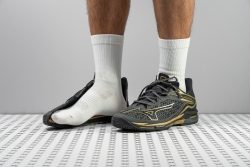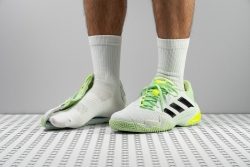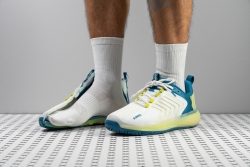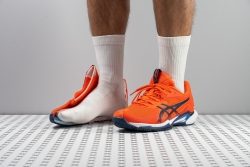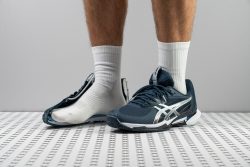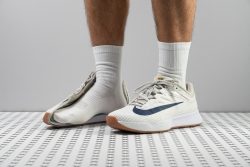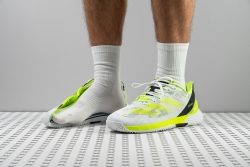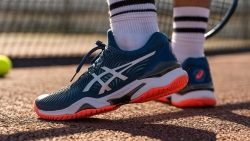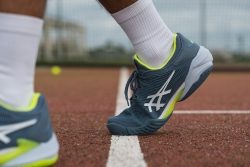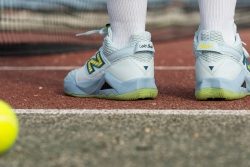7 Best Plantar Fasciitis Tennis Shoes in 2025
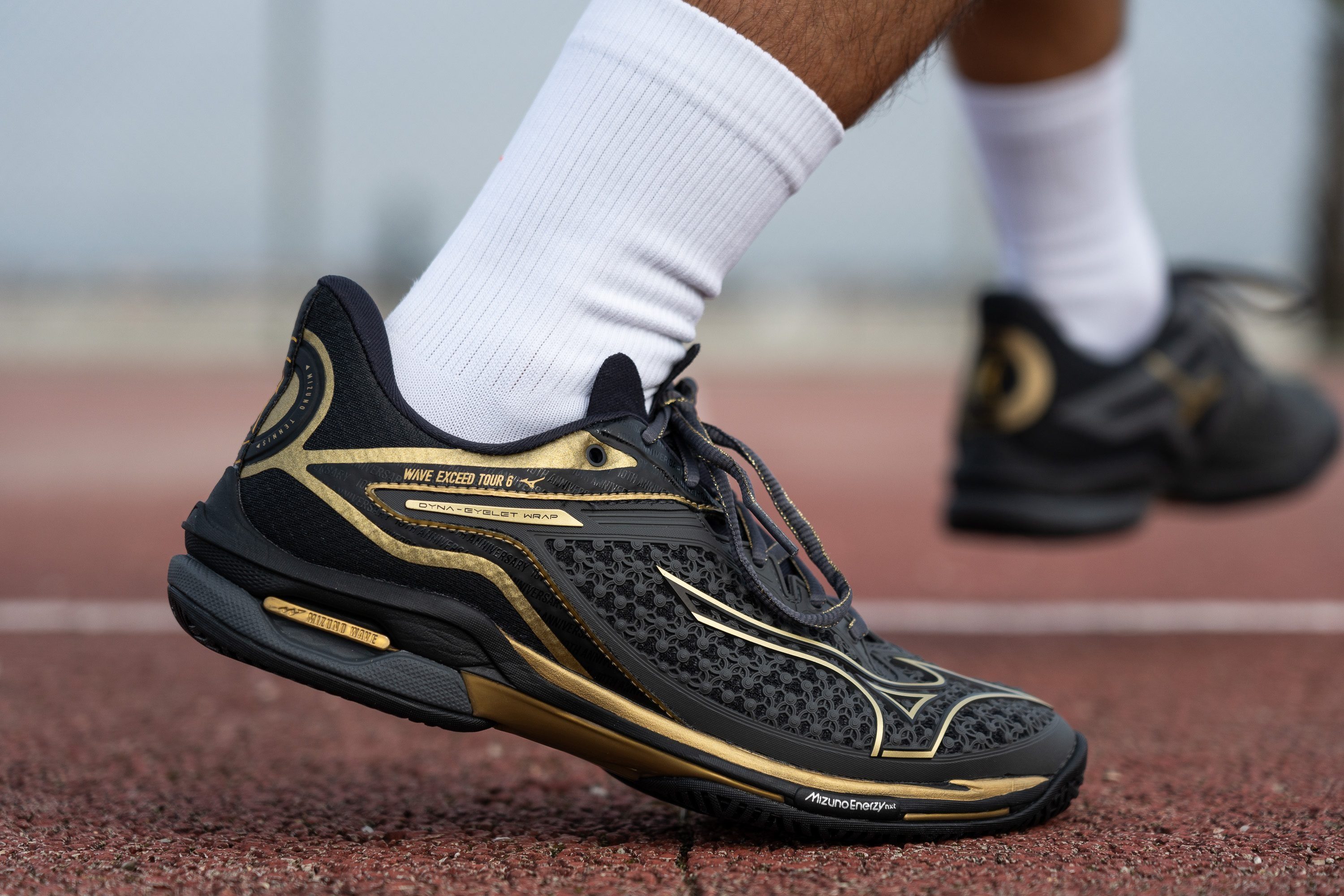
We buy shoes ourselves. We earn commissions when you buy through us, at no extra cost. Why trust us
Affecting 1 in every 10 adults, plantar fasciitis (PF) can become a painful roadblock on your way to enjoying tennis matches and practises. But the good news is that some tennis shoes can help minimise the pain or even prevent triggering it in the first place.
Check out our top picks below and scroll down for more nuanced information on choosing tennis shoes for PF.
How we test plantar fasciitis tennis shoes
We carefully study the research behind this painful condition and the type of tennis shoe characteristics that can help it.
Meanwhile, we test and measure 30+ shoe parameters in our own shoe lab to filter out the tennis shoes that meet that criteria. We follow the industry’s acclaimed methods for testing shock absorption, heel-to-toe drop, cushioning softness, etc.
We also purchase all tested shoes with our own funds to remain bias-free.
Best tennis shoes for plantar fasciitis overall
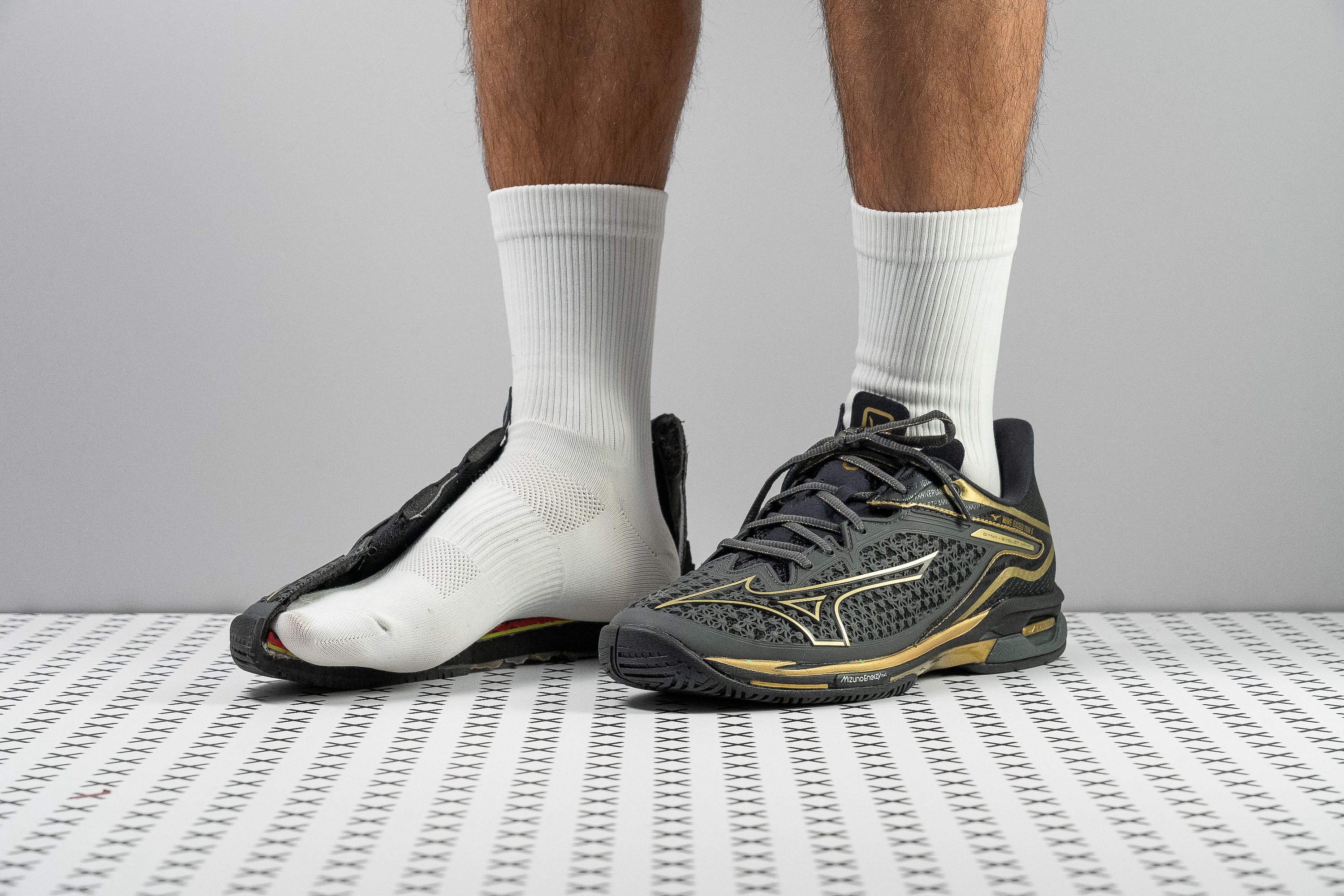




















































What makes it the best?
The Mizuno Wave Exceed Tour 6 offered a unique balance of support and adaptability that allowed us to perform long rallies without worrying about foot pain. Our lab results validate it’s rigid and pliable in the right areas, all in a lightweight package, boosting speed, stability, and comfort. It’s hard to find another shoe that can match this pair, so we rank it as the best plantar fasciitis tennis shoe.
From split steps to crossovers, we had no second thoughts about our next move. The shoe has a rigid foothold that made us feel so secure. We discovered it features the stiff Wave plate, which boosted torsional rigidity to a high 4/5 score. Ankle shifts were also out of the picture when we rated the heel counter with the maximum 5/5 stiffness score, which prevents additional strain to our heels.
When it comes to bending our feet, the shoe moves with us naturally. We were relieved to find a D-Flex Groove running through the midsole for enhanced flexibility. We validated that this pair is 32.7% more pliable than average.
Performing dynamic footwork feels easy in this pair because of its light 11.7 oz (332g) build. For reference, that’s 7.8% below average, which helps prevent fatigue.
It’s hard not to love this shoe, but we recommend highly aggressive sliders to go for a pair with more medial reinforcements.
Pros
- Lighter than average speedy
- Bouncy and responsive cushioning
- Very stable for a lightweight shoe
- Unusually flexible
- Secure midfoot lockdown
- Perfect grip on hard court
- Excellent overall durability
- 6-month outsole durability guarantee
Cons
- Not very breathable
- Toe drag guard is not very sturdy
- Laces bite when cinched tightly (or when a runner's knot)
Tennis shoes for plantar fasciitis with the best stability
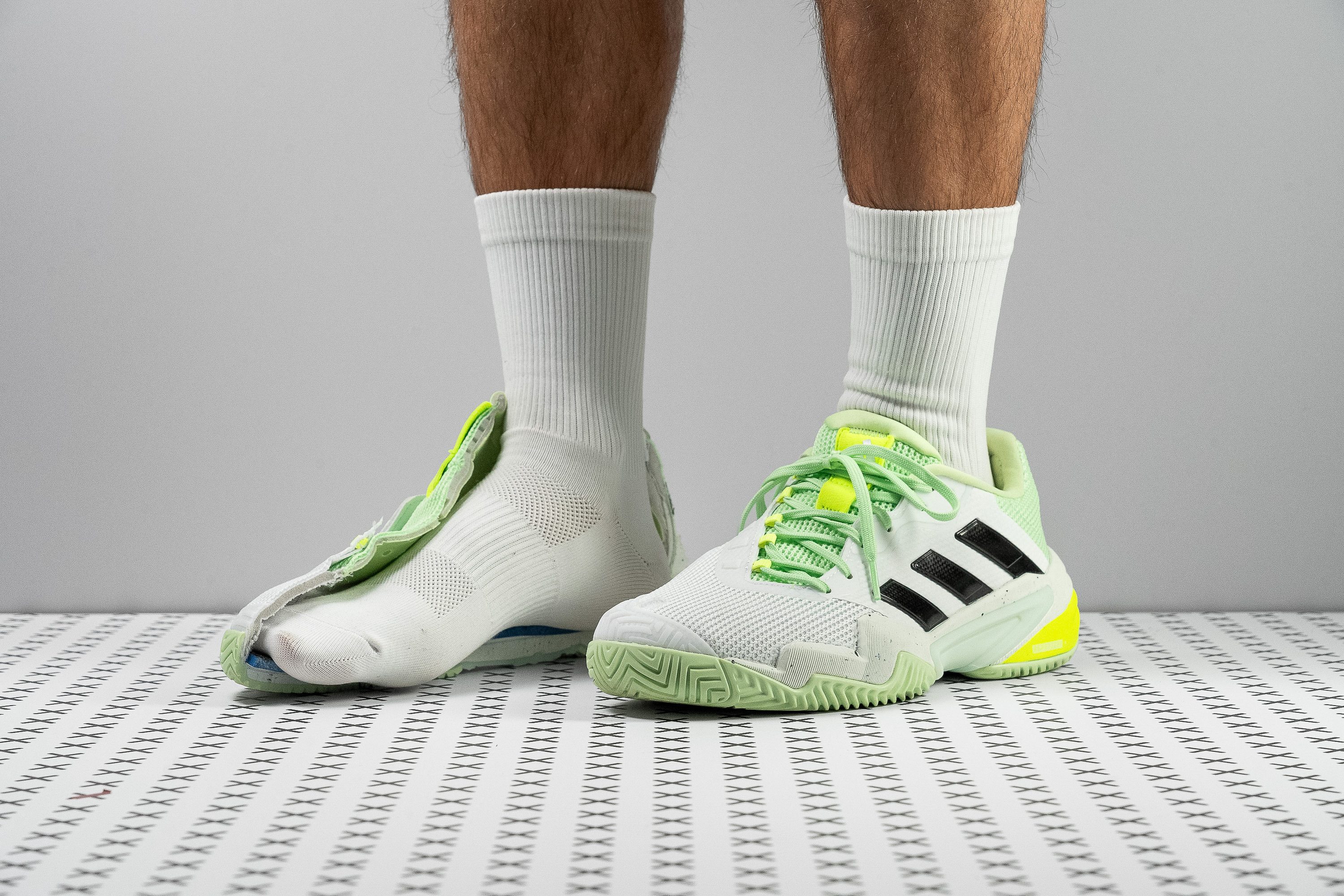

















































What makes it the best?
ââAfter countless hours on the court and inside the lab, we can attest to the Adidas Barricade 13 offering the best stability among plantar fasciitis tennis shoes. Besides its generous width, our feet felt secure in the platform due to its stiff midsole and reassuring heel hold. To take pressure off our heels, the midsole provides excellent impact protection and features a steep drop.
It's hard to lose balance in the Barricade 13 even as we perform dynamic footwork. The midfoot has a TPU that acts as a barrier against ankle twists and rolling over the edge. In our torsional rigidity test, we couldn’t rate it anything lower than 5/5. It also received the top score in heel counter stiffness, which helps avoid foot strain because we remain centred.
Barricade 13 features wide dimensions that keep us surefooted. Our calliper shows it’s 115.4/95.3 mm, much more spacious than the 111.8/89.6 mm average, and leaving no room for any missteps.
To protect our feet from hard landings, the cushion offers much-needed shock absorption. We measured the heel area with a 102 SA score, which is high enough to avoid triggering heel pain from impact. The steep 11.3 mm drop also takes the load away from the rear section.
Unfortunately, this shoe made us overheat in the summer. Those who want free-flowing ventilation should go for a more breathable pair.
Pros
- Exceptional stability and arch support
- Wide and steady platform
- Hard-wearing outsole with a 6-month guarantee
- Fantastic outsole grip
- Sufficient impact protection
- Great court feel
- Highly secure foothold and lockdown
- Outsole grips and slides well
Cons
- Upper is not the most durable
- Cushioning lacks bounce and responsiveness
Tennis shoes for plantar fasciitis with the best shock absorption
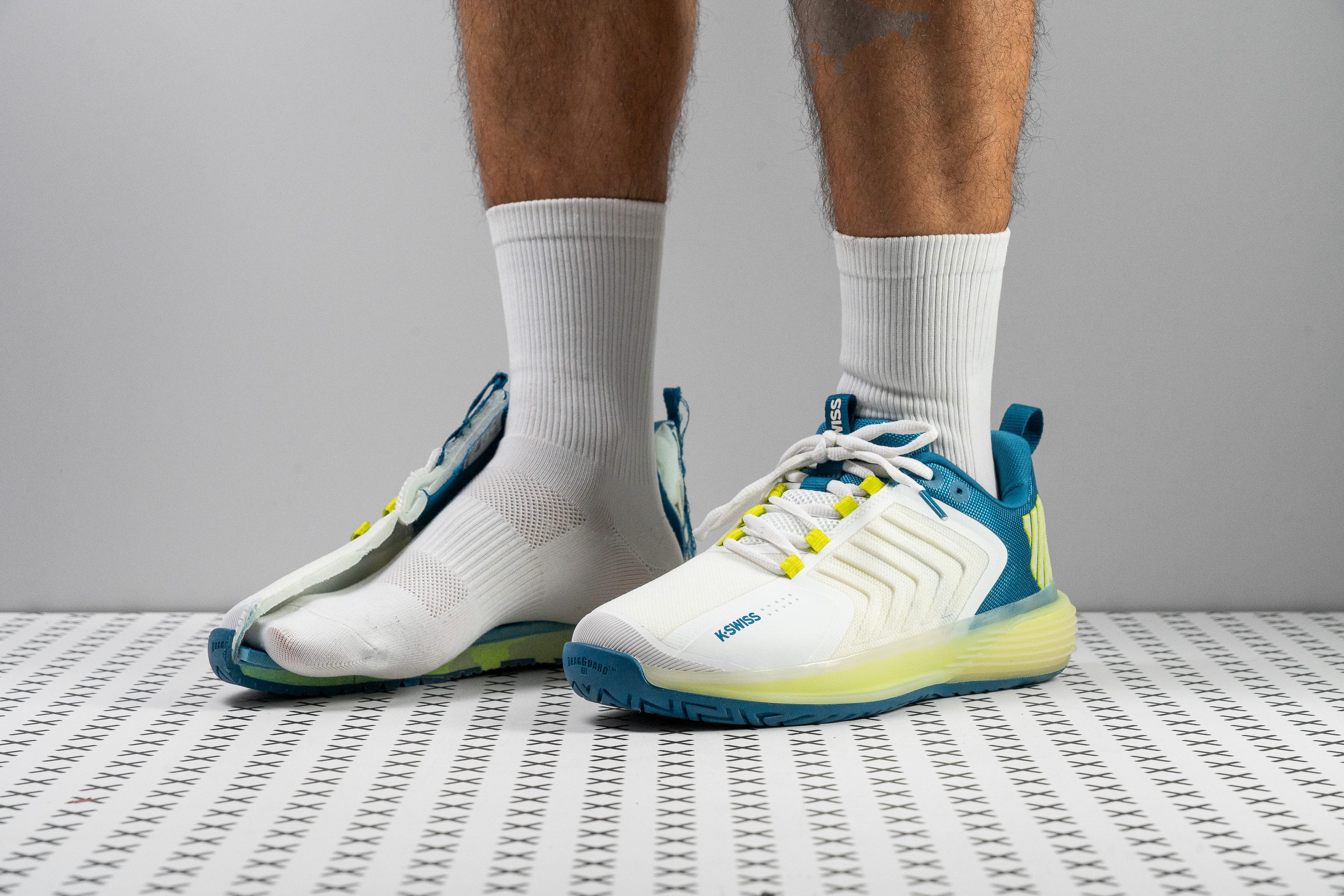










































What makes it the best?
Repetitive matches, running around the court, and hours in the lab led us to discover the K-Swiss Ultrashot 3 as the plantar fasciitis tennis shoe with the best shock absorption. We have the numbers in the lab, but our feet truly enjoyed gentle landings. To ensure support, it has stabilising components in the right areas, such as its stiff heel counter and 360 Plantar Chassis.
We follow a strict and standardised method of measuring shock absorption in the lab and got a high rating of 109 SA in the heel, offering 9.0% better impact protection than average. Meanwhile, the forefoot attained an average 64 SA reading, ensuring we have good court feel.
To ensure we don’t strain our heels and overwork our feet, the Ultrashot 3 has tonnes of support care of its 360 Plantar Chassis. It consists of a midfoot shank with a stiff cage around it for a highly stable experience.
Even while performing multi-directional changes in footwork, we felt confident in the shoe. In our manual assessment, both the heel counter and torsional rigidity recorded above-average scores of 5/5 and 4/5, respectively, confirming their reassuring support.
However, Ultrashot 3 tipped the scales to a heavy 14.0 oz (397g). Those who prefer a more agile experience should check alternatives.
Pros
- Abundant shock absorption
- Great lateral stability and support
- Superb outsole traction
- Highly durable outsole
- Secure lockdown
Cons
- Static unresponsive ride
- Upper could be more durable
- Lacks breathability
Best lightweight tennis shoes for plantar fasciitis
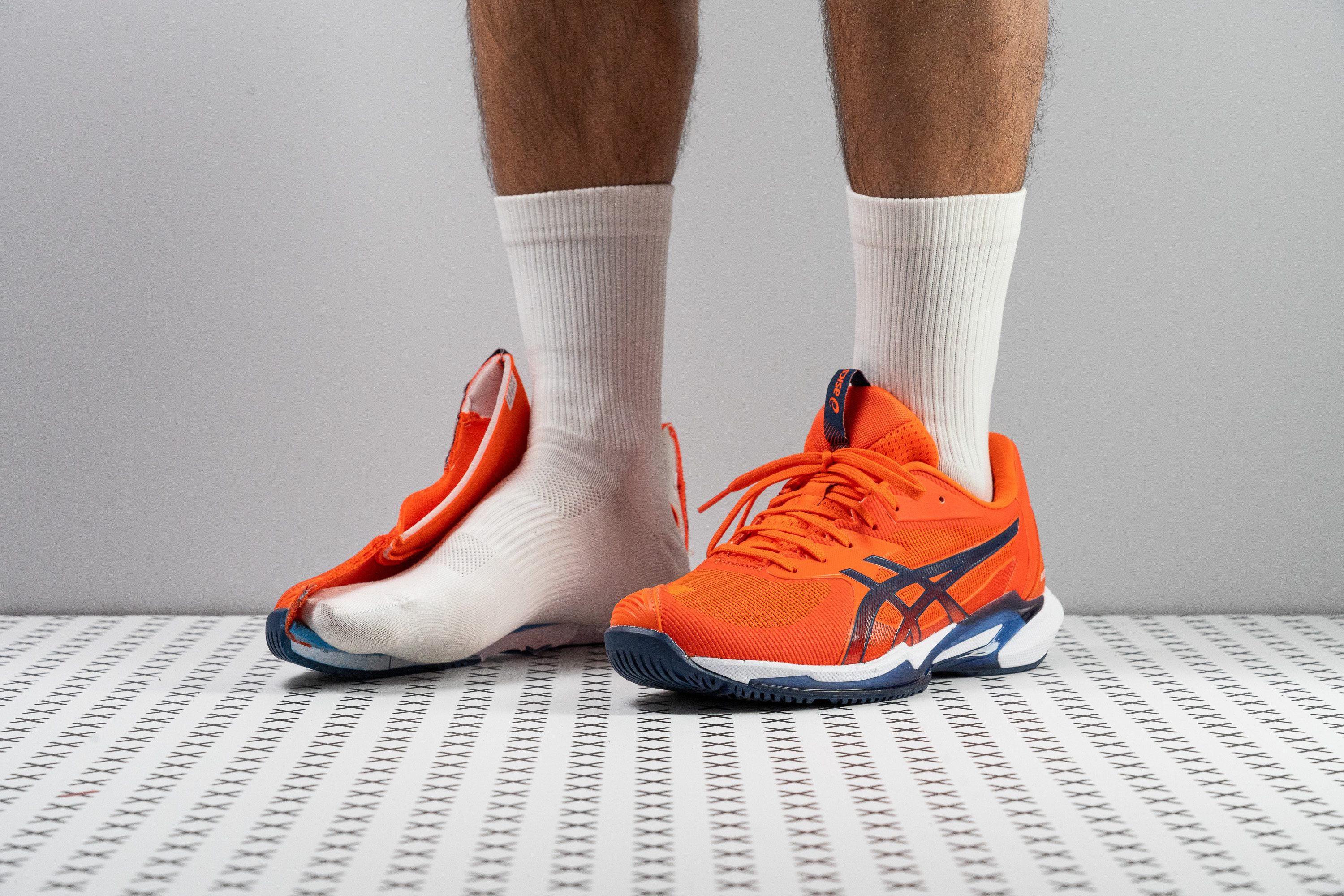















































What makes it the best?
From taking off for a shot or launching hard dashes cross-court, the ASICS Solution Speed FF 3 gave us the best lightweight experience among plantar fasciitis tennis shoes. Besides its undeniably light build, we discovered in the lab that it features a flexible and grounded midsole. Thankfully, it offers support in the right areas and delivers a well-cushioned feel for harsh landings.
Our scales confirmed what our feet experienced: this shoe only weighs 10.9 oz (309g), 14.2% below average. Its effortless sensation becomes more pronounced when it takes minimal effort to bend our feet. In our standardised lab test, it's 6.2% more flexible than average.
Solution Speed FF 3’s nimble energy comes from its below-average. 28.3/18.5 mm stack. Thankfully, it feels well-cushioned for landings and doesn’t trigger heel pain. Returning a high 104 SA score in the heel, we validated its impact protection.
Too much flexibility can cause our feet to overwork, so we were pleased to find the Speedtruss shank that adds structure to the midsole. In our torsional rigidity test, it received a high 4/5 rating, boosting stability. Plus, its firm heel hold (5/5) ensures we won’t do excessive movements that can worsen plantar fasciitis.
Because of this pair’s slim dimensions, it may cause pressure points or instability for wide feet. Those who need more internal real estate should opt for a more accommodating shoe.
Pros
- One of the lightest tennis shoes on the market
- Fantastic wear resistance and durability
- Exceptionally breathable for a tennis shoe
- Grounded platform with a great court feel
- Rockered heel makes transitions faster and smoother
- Solid stability for a speed-oriented shoe
- Perfect grip with enough give
- Perfect grip with enough give
Cons
- Not for wide feet
- Not very stable for baseline players
Best tennis shoes for plantar fasciitis for clay court
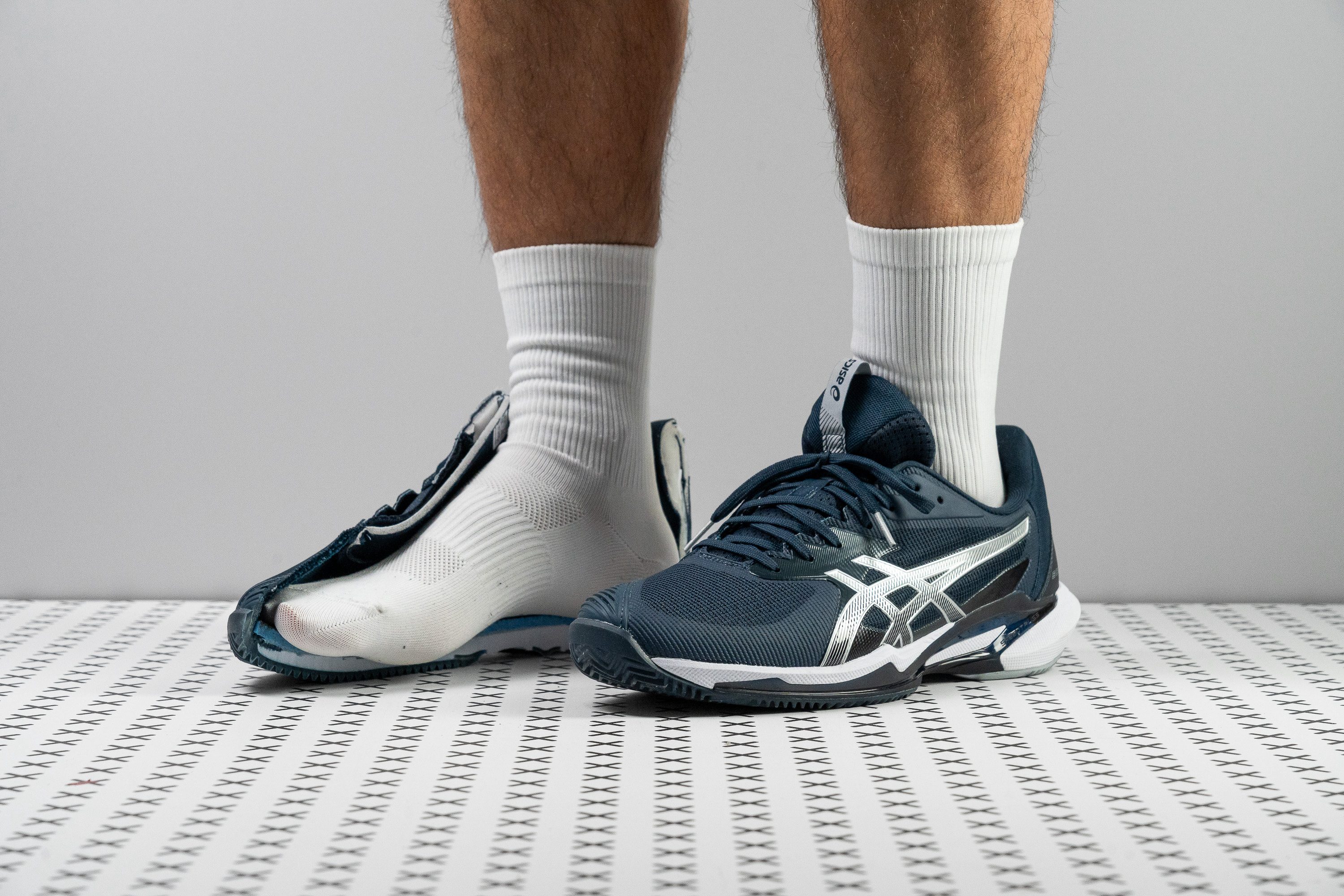










































What makes it the best?
The ASICS Solution Speed FF 3 Clay kept us in control of each movement we made through its awesome court connection, grippy outsole, and structured build. Our lab verifies that its speed comes from its light weight, while the Speedtruss shank ensures that we prevent straining our feet. Therefore, it’s our best plantar fasciitis tennis shoe for clay courts.
Our scales proved the agility we enjoyed by confirming the shoe’s light 10.8 oz (306g) weight, 15.0% below average. The cushion offered a good court feel through its below-average 35.8% energy return in the forefoot. This level helps prevent excessive motions and allows us to adapt to the surface easily.
Meanwhile, the outsole features a deep herringbone tread pattern designed for clay courts. We could stop and slide as we pleased and earned a satisfactory 0.72 score in our traction test.
In the midfoot, we found the Speedtruss shank as its core stabiliser. As a result, it was difficult for us to twist the shoe in our assessment, earning it the top 5/5 torsional rigidity rating, and therefore enhancing our surefootedness. The rear side of our foot also felt locked in because of the stiff heel counter, which also got the maximum 5/5 score on our test.
However, we can only recommend this pair to players with narrow or medium-width feet. Its toebox may feel tight for wide-footed folks.
Pros
- One of the lightest tennis shoes out there
- Highly agile and manoeuvrable
- Secure heel and midfoot lockdown
- Bevelled heel creates a smoother ride
- Great lateral stability for a speed shoe
- Impressive durability given the lighter build
- Good grip with effortless sliding
Cons
- Not for baseline players
- Not for wide feet
Tennis shoes for plantar fasciitis with the best versatility







































What makes it the best?
The Nike Vapour Pro 3 proved to be an all-rounder during our playtests, offering speed for split-second scrambles to the net, court connection, and stability for hard lateral movements. Lab results reveal its midsole is flexible, making it adaptive to our quick footwork. Overall, it’s our best versatile plantar fasciitis tennis shoe.
The 28.6/20.0 mm platform feels well-balanced and is on par with average. Impact protection is high in the heel (104 SA) and lower in the forefoot (58 SA) for heightened surface feedback and control. We could instantly chase the ball as needed, and our energy return test shows impressive 50.0% and 51.0% scores.
The shoe offers a firm foothold and strong resistance against ankle twists, evidenced by its high 4/5 torsional rigidity rating in our manual assessment. The integrated eyelets create an adjustable fit for the whole midfoot area, which helps us feel more secure.
It’s impressive that Vapour Pro 3 doesn’t lose its longitudinal flexibility despite its stable ride. Needing 15.7N to reach 30 degrees, it’s more bendable than average, which enhances both comfort and adaptability.
Unfortunately, it tipped the scales to a heavy 13.1 oz (383g). Players seeking top agility should find a more lightweight shoe.
Pros
- Highly secure midfoot lockdown
- Solid lateral support and stability
- Reliable impact protection
- Good mix of cushioning and court feel
- Predictable medium fit
- Fantastic durability (even in high-wear areas)
- Nice balance of grip and give
- Comfortable step-in feel
Cons
- Smaller Zoom Air unit has lower energy return
- No added flexibility (as promised)
- Still heavier than average
- Not so breathable
Tennis shoes for plantar fasciitis with the best value for money
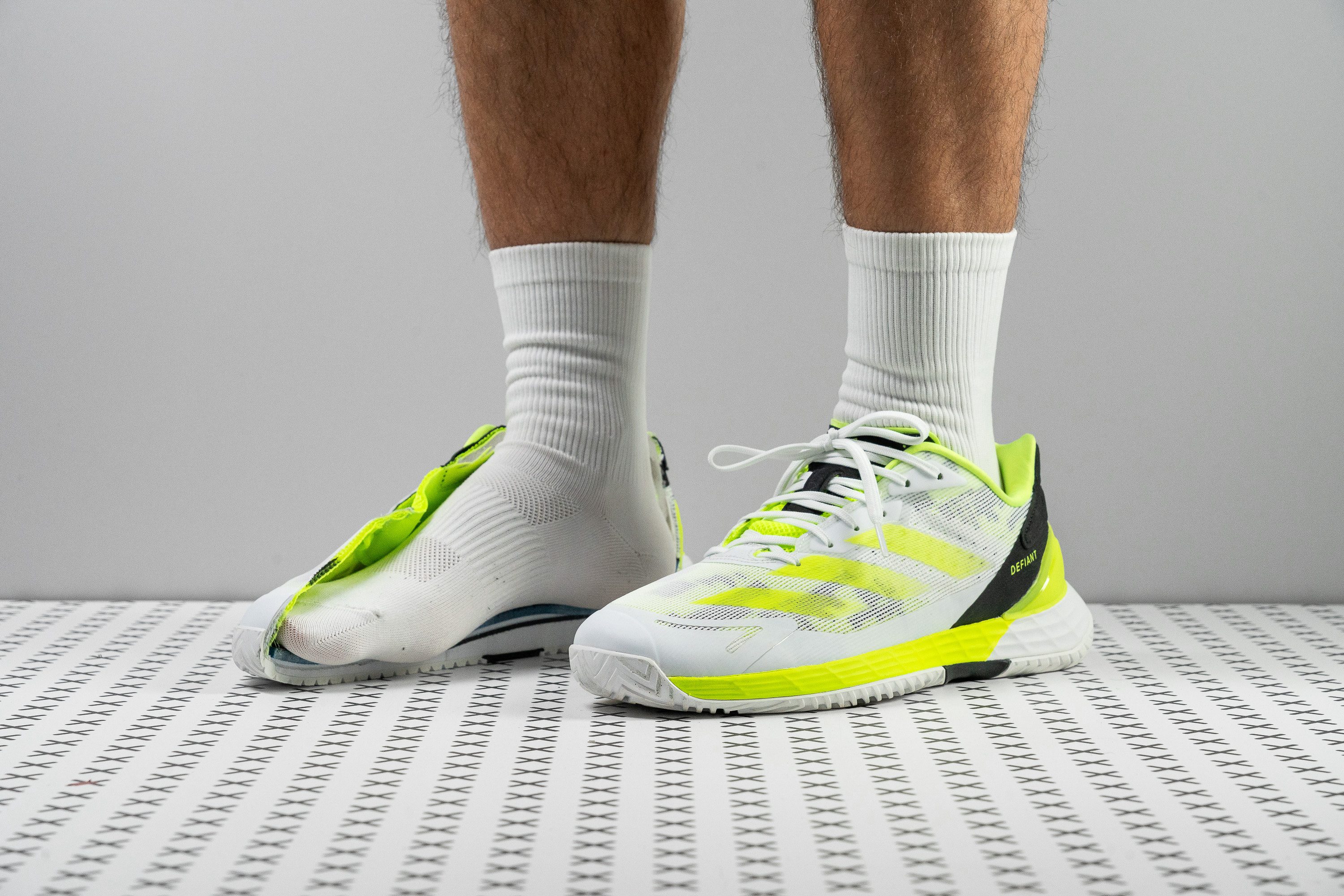












































What makes it the best?
Multiple tests on and off court can back us up when we say the Adidas Defiant Speed 2 offers the best value among plantar fasciitis tennis shoes. In the lab, we verified that its accessible £120 price and light build don’t sacrifice speed, impact protection, and support.
When we measured Defiant Speed 2’s shock absorption, it attained a high 105 SA score, reassuring us that our heels will feel protected even for longer rallies. Paired with a ground-connected forefoot, it features a high 11.8 mm drop that takes the weight and strain off our heels.
When it’s time for quick and explosive movements, we don’t feel like toppling over or twisting our ankles. An internal shank is embedded into the midsole, which explains its high torsional rigidity score of 4/5.
Defiant Speed 2 is not only easy on the pocket, but it’s light on foot too! Besides its low 12.2 oz (347g) weight, it also offers room for bending. In our flex test, we found it to be 18.4% more pliable than average, explaining the nimbleness we felt during our matches.
We think the upper design can be improved for better lockdown since the steep drop results in some toe jamming. Best to secure the fit before rallying on court.
Pros
- Grounded platform with good court feel
- Stable base for a speed shoe
- Generously padded insole
- Fairly flexible forefoot
- Impressive durability for the money
- Great balance of grip and give
- Great balance of grip and give
Cons
- Not everyone can achieve a secure lockdown (especially skinny feet)
- Higher drop may cause toe jamming
Symptoms and causes of plantar fasciitis
There are numerous causes of sharp pain in the heel, but plantar fasciitis (PF) is one of them.
Inflammation of the plantar fascia ligament, PF is most likely to occur due to overuse, wearing subpar or worn-out footwear*, and other conditions that cause the plantar fascia to compensate for calves, Achilles, or other muscles and tendons.
*Think of the last time you replaced your tennis shoes. Even if they don’t have any obvious signs of wear, shoes start to lose their initial cushioning and support after a given number of hours on the court. Their lifespan gets even shorter if you play regularly or if you are a heavier player. Having two pairs of tennis shoes in rotation can help, and it is, in fact, one of the PF prevention strategies.
Some of the surefire symptoms of PF include the following:
- Heel pain intensifies after stepping on your foot after a long period of rest or sleep.
- The pain gets worse towards the end of the tennis match or practice.
- The pain can shoot from the heel to the midfoot.
- Palpating the plantar fascia causes soreness.
- Passively bending your big toe by hand causes pain or discomfort.
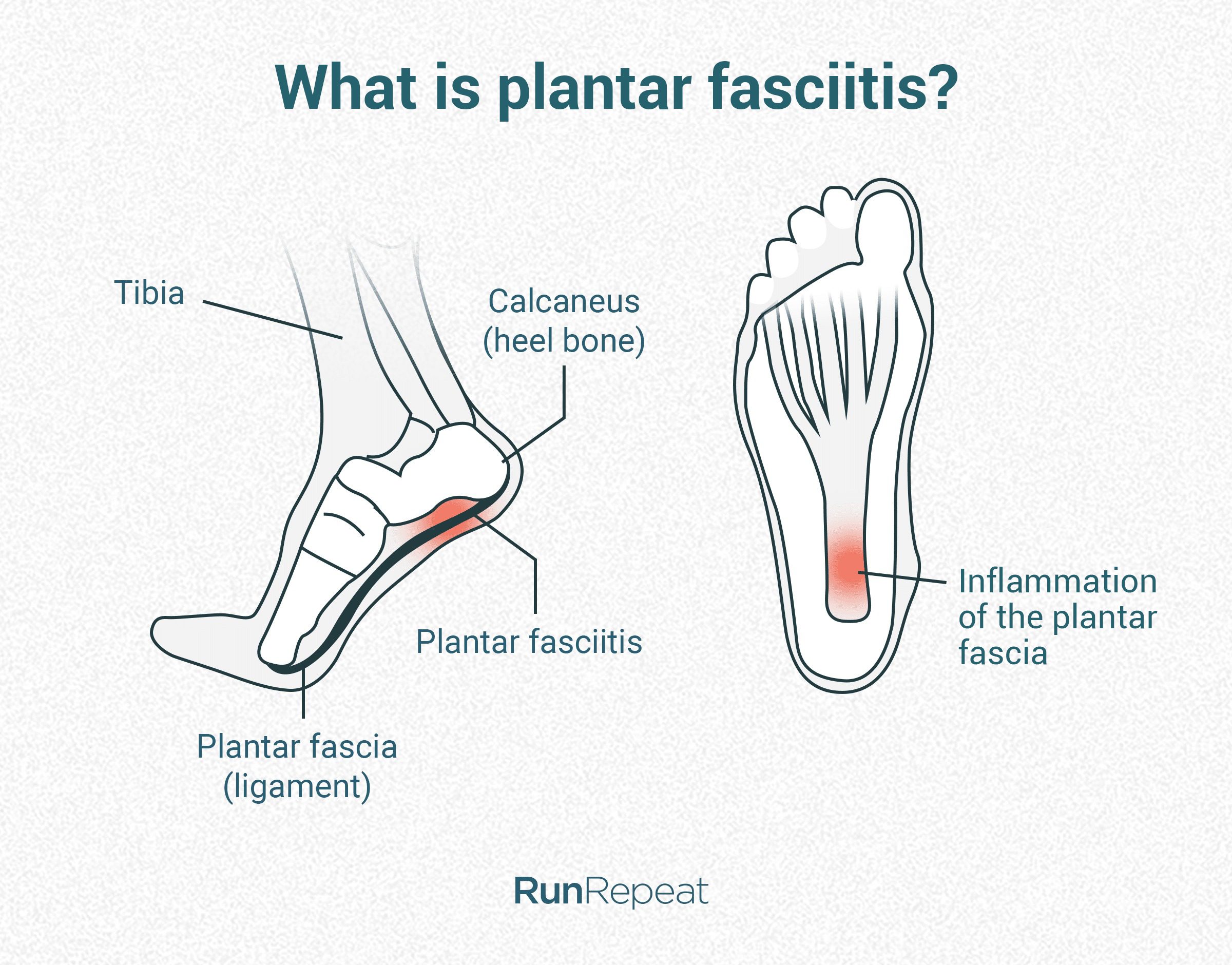
But we all know that Googling or ChatGPTing your symptoms is never a good idea, so we highly recommend consulting a doctor (preferably a podiatrist) to confirm your diagnosis, prescribe the necessary treatment, and make personal recommendations regarding tennis shoes and insoles.
TIP: Not everyone is lucky enough to know a podiatrist who works with athletes (ideally, tennis players). That’s why it is important to emphasise that you need shoes for court sports and not only for day-to-day wear. Most running shoes and trainers aren’t suitable for the dynamic nature of tennis.
What tennis shoes to choose for plantar fasciitis
A pair of shoes is not a cure for PF, but there are certain characteristics that you should look for if you want to avoid aggravating the condition and continue playing with less pain and discomfort.
What to look for in tennis shoes for plantar fasciitis:
- High shock absorption. Well-cushioned shoes minimise the impact.
- High heel-to-toe drop. Raised heel (8 mm or more) takes the pressure off the foot.
- Moderately soft or firm midsole. Plush cushioning can irritate the ligament.
- High torsional rigidity. Less shoe twisting keeps the foot more stable.
- High heel counter stiffness. Rearfoot lockdown minimises wobbles and foot strain.
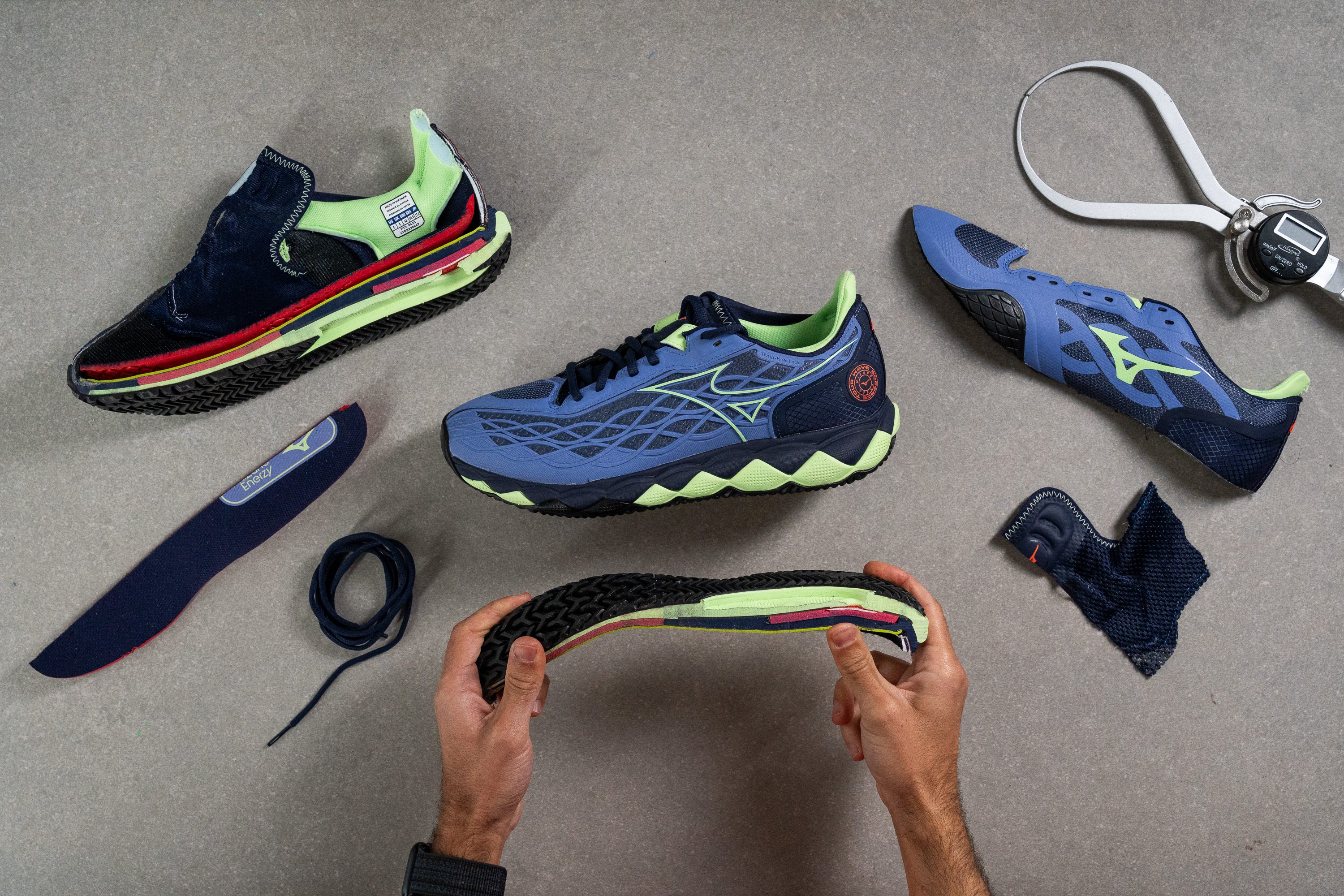
1. You need good cushioning and shock absorption
Hard landings, sudden stops, and jump shots all put a tonne of stress on your plantar fascia tissue. Considering all the impact your feet sustain during the tennis match, it is crucial to choose shoes with excellent shock absorption.
Honouring the ASTM F1976 standard for measuring shock absorption (SA), we perform meticulous tests to record each tennis shoe’s SA reading. The higher the number, the better the impact protection.
To ease the pain and discomfort caused by plantar fasciitis, we recommend sticking to tennis shoes with at least 100 SA.
2. High heel-to-toe drop is a must for players with plantar fasciitis
Drop refers to the difference in height between the shoe’s heel and forefoot stack. The higher the drop, the higher your heel sits above the toes inside the shoe.
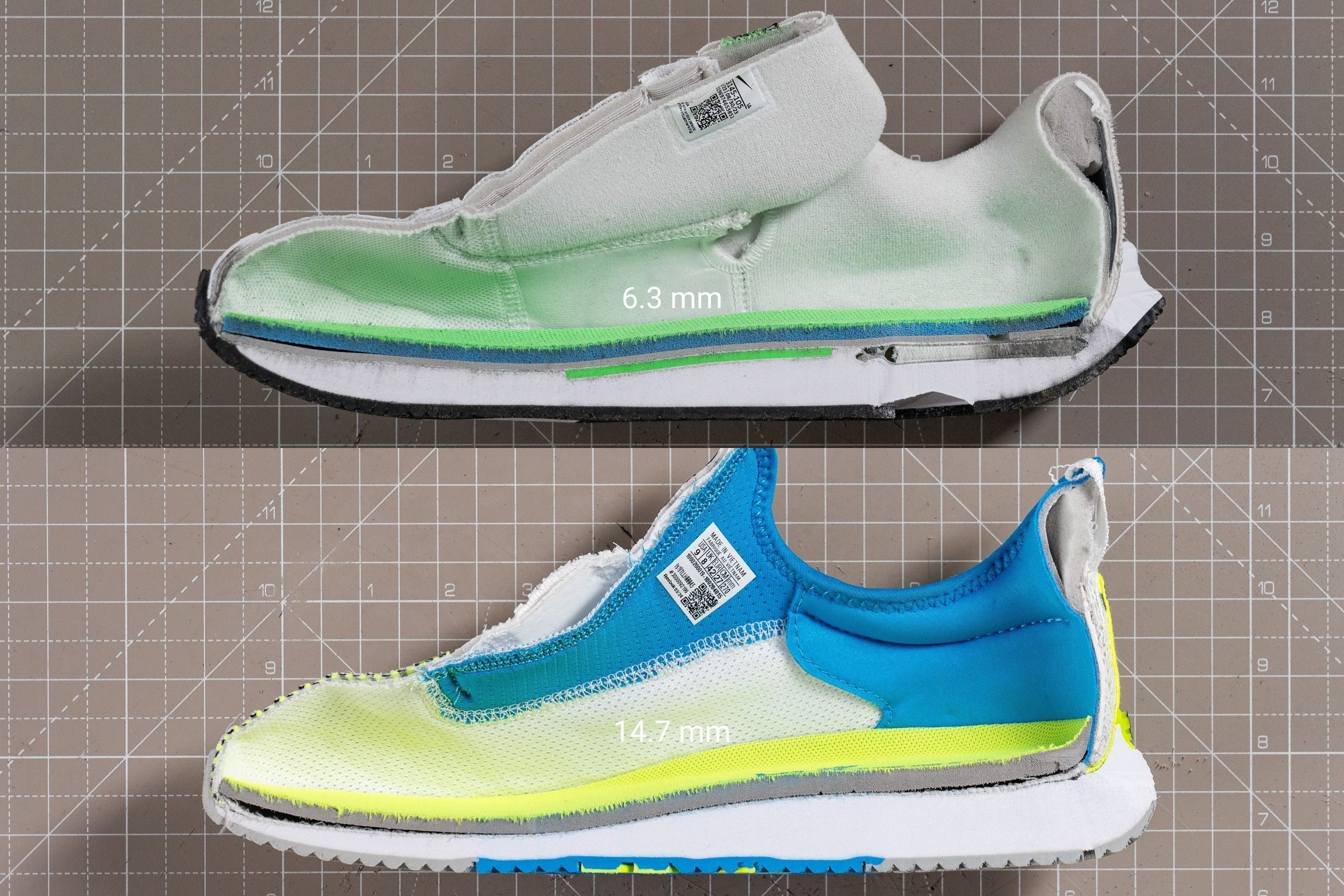
We cut all tested tennis shoes in half and use a digital calliper to measure their stack height and drop in accordance with the rules set by World Athletics.
The drop in tennis shoes typically ranges from 6 to 14 mm, but we recommend choosing at least 8 mm if you want to lower the stress and strain on your feet.
Low-drop shoes put the foot in a nearly flat position, which lengthens the plantar fascia, forcing it to work more. And if you have poor ankle mobility and tight calves, the stress gets even worse.
3. Avoid tennis shoes with soft cushioning
Why? Because your foot sinks into the plush foam, its muscles and tendons need to work harder to stabilise the foot.
But the good news is that you can hardly find a tennis shoe with plush cushioning given the dynamic and multi-directional nature of this sport.
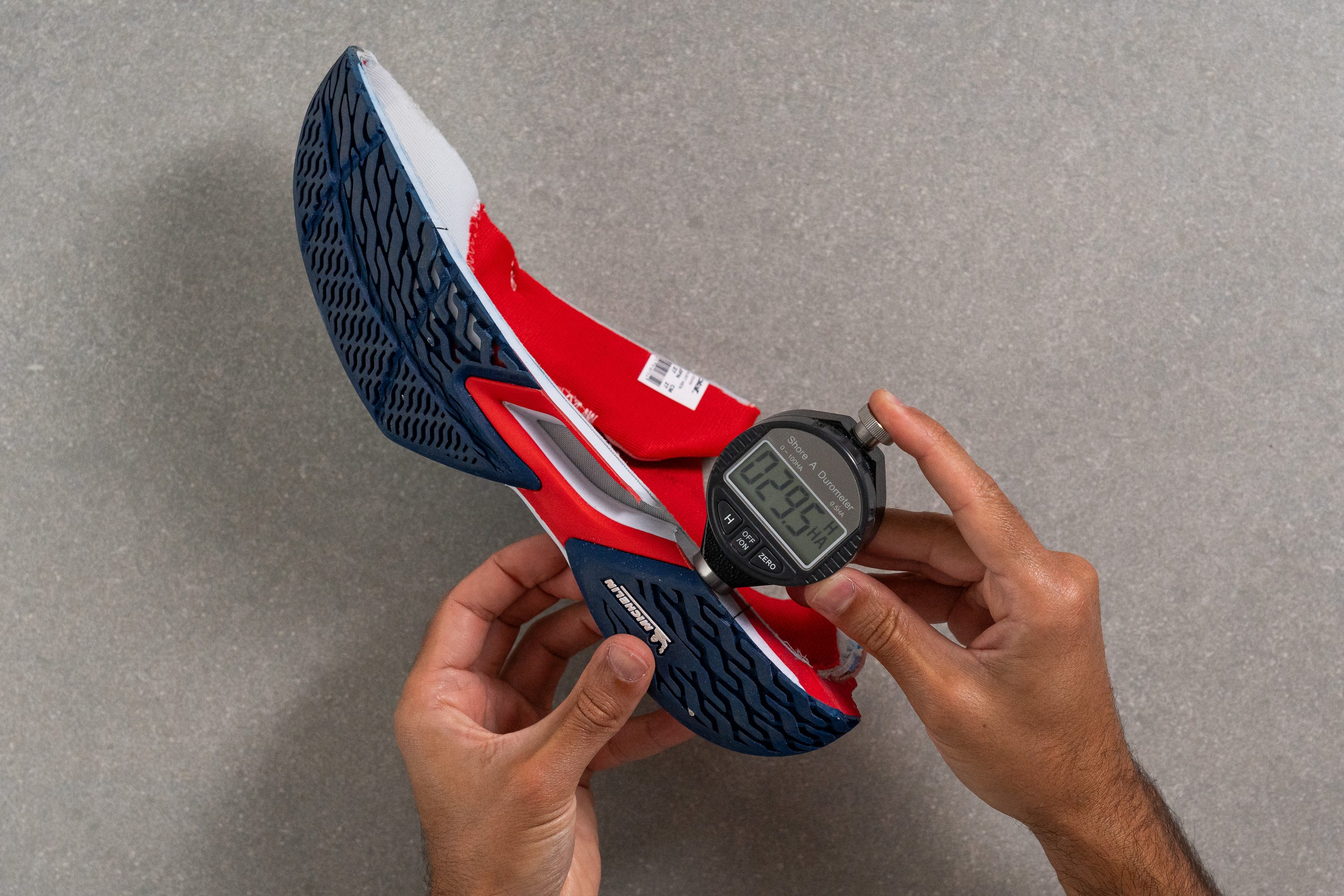
Based on our Shore A durometer measurements, the cushioning foam of most tennis shoes hovers around 28-30 HA (the higher the HA reading, the firmer the foam). For a moderately soft or firm underfoot experience, choose shoes with at least 25 HA.
4. You want highly stable tennis shoes for plantar fasciitis
Overly flexible tennis shoes can trigger the PF pain pretty quickly because they don’t offer as much stability and support.
How to know if a shoe is too forgiving? If you can wring it with your hands like a towel, that’s not what you need. There should be so much torsional rigidity that you can hardly twist it.
We perform the same manual test on all tennis shoes and rate their stiffness on a 1-5 scale (the higher the number, the stiffer the shoe). For PF, it’s best to choose shoes with a torsional rigidity of 4/5 or 5/5.
5. Don’t overlook the heel counter
When you have PF, it’s best to delegate as much stabilisation work as possible from the foot to the shoe.
A stiffer heel counter offers a steady cradle at the back of the foot, minimising shifts and wobbles during intense lateral movements on the court.
We rely on a manual push-and-squeeze test to assess the rigidity of each shoe’s heel counter on a 1-5 scale (5 being the stiffest). For PF, we only recommend shoes that scored 3, 4, or 5 in our heel counter stiffness test.
You also want to be sure that the shoe’s heel padding bodes well with your ankles. And if you have sensitive Achilles, you may want to go for a bit less stiff heel counter (3/5 as opposed to 5/5).

